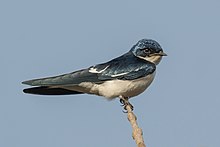
Back Ажәҵыс Abkhazian Swael Afrikaans Schwalben ALS በቋል Amharic 'alolil AMI Hirundinidae AN سنونو Arabic سنونو ARZ Hirundinidae AST Cacawoni pirecic ATJ
| Swallow Temporal range:
| |
|---|---|

| |
| Pied-winged swallow Hirundo leucosoma | |
| Scientific classification | |
| Domain: | Eukaryota |
| Kingdom: | Animalia |
| Phylum: | Chordata |
| Class: | Aves |
| Order: | Passeriformes |
| Suborder: | Passeri |
| Family: | Hirundinidae Rafinesque, 1815 |
| Genera | |
|
21, see text | |
The swallows, martins, and saw-wings, or Hirundinidae are a family of passerine songbirds found around the world on all continents, including occasionally in Antarctica. Highly adapted to aerial feeding, they have a distinctive appearance. The term "swallow" is used as the common name for Hirundo rustica in the UK[1] and Ireland.[2] Around 90 species of Hirundinidae are known, divided into 21 genera, with the greatest diversity found in Africa, which is also thought to be where they evolved as hole-nesters.[3] They also occur on a number of oceanic islands. A number of European and North American species are long-distance migrants; by contrast, the West and South African swallows are nonmigratory.
This family comprises two subfamilies: Pseudochelidoninae (the river martins of the genus Pseudochelidon) and Hirundininae (all other swallows, martins, and saw-wings). In the Old World, the name "martin" tends to be used for the squarer-tailed species, and the name "swallow" for the more fork-tailed species; however, this distinction does not represent a real evolutionary separation.[4] In the New World, "martin" is reserved for members of the genus Progne. (These two systems are responsible for the same species being called sand martin in the Old World and bank swallow in the New World.)
- ^ "Swallow Bird Facts". RSPB. Retrieved 8 May 2024.
- ^ "Swallow". Birdwatch Ireland. Retrieved 8 May 2024.
- ^ Angela Turner; Chris Rose (2010). A Handbook to the Swallows and Martins of the World. A&C Black. p. 12. ISBN 9781408131725.
- ^ Turner, Angela; Rose, Chris (1989). Swallows and martins: an identification guide and handbook. Houghton-Mifflin. ISBN 978-0-395-51174-9.